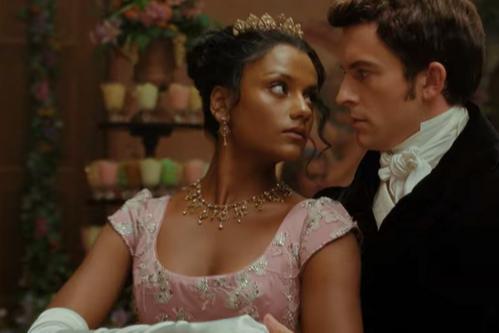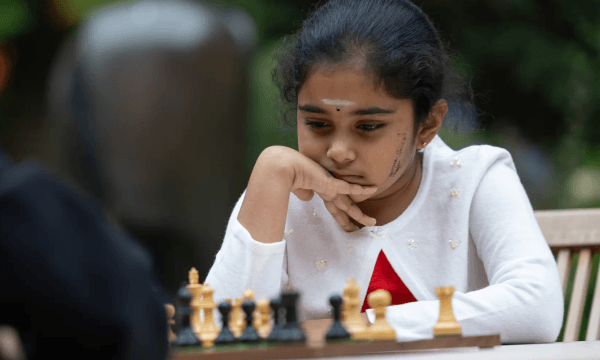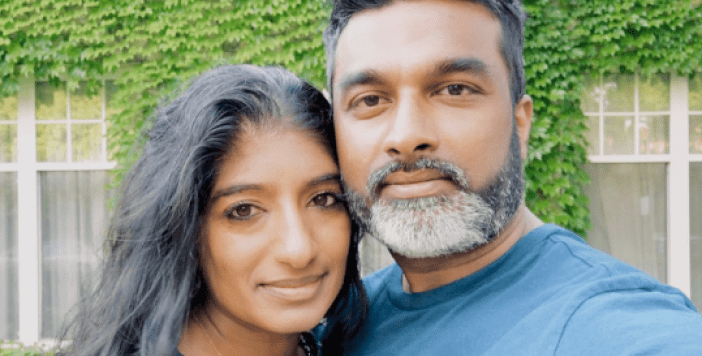
Date on your own terms! Find meaningful connections on myTamilDate from Toronto to London to Berlin!
This is not an article on shadeism. I think everyone is aware of the prevalence of shadeism in the Tamil community. This article came from conversations with some friends, mostly Tamil women, about Bridgerton, and their take on how Bridgerton’s portrayal of Kate Sharma is an important and positive defining moment, not just in Tamil representation, but in dark-skinned Tamil representation, romance and women on screen.
We all know about Tamil movies and their obsession with light skin, especially for women. Having the extremely light-skinned heroine among a throng of darker dancers, or the heroine being contrasted with a supposedly less desirable dark-skinned girl is a pretty standard plot point, to the point you get used to it. Simone Ashley is undoubtedly darker-skinned than the average South Asian actress typically cast in leading roles. For my friends, the significance of Simone Ashley’s casting and portrayal in Bridgerton did not just come down to seeing a brown girl on screen. It was closely tied with the taboo around sex and intimacy, shaming and bullying.
At the beginning my friends were talking about some common challenges that they, as dark-skinned women, had faced growing up. This included bullying and judgement for their skin tone from family members and classmates, comparisons to their light-skinned cousins and siblings, and being made to feel less than and less beautiful for simply being darker. “If she got her sister’s colour she would be so much more pretty is something my mom said to me alot”, one of my friends said while rolling her eyes. Judgement in the community tied with a lack of on-screen representation of dark-skinned brown women portrayed in a positive light fueled a lot of self-confidence, self-esteem, and self-worth issues as they grew up.
My friends touched on another very important point where movies, both Tamil and western, historically portrayed South Asian women’s sexuality terribly. Brown women in western movies, when present, are usually studious, docile, submissive and sexually inexperienced. In Tamil movies, portrayals of sex are similarly tip-toed around. Tamil movies often portray love and intimacy through melodious music, longing stares from across the room, or hands brushing against one another. Men obsessively chase after women, while the self-respecting woman either shuns him or puts her head down and silently walks away in fear.
“There might be a hug here and there, but no kissing, and definitely no sex. It’s just glances. It never really broke the mind barrier that brown women could confidently own their beauty or sexuality like white women in Hollywood.” It was also said that the carefully “manicured” and subtle depictions of love on screen made it seem like outward, confident expressions of desire were inappropriate.
One of my friends shared that on top of this, “the fact that every single woman presented in these love scenes was usually a light-skinned model-turned-actress, it really felt like there were these limits to what darker-skinned girls were allowed to desire. Watching Bridgerton made me think about my younger self and how she would always be afraid of approaching guys she had a crush on because she thought they immediately wouldn’t like her because she wasn’t light enough to be seen as desirable.”
Another friend chimed in, “If I had a crush, I would immediately rule out the idea of me having a chance, because I assumed my crushes liked lighter-skinned girls, and I didn't want these guys to confirm my own beliefs and reject me for the same reasons.” There was this subconscious message to darker-skinned women about who was allowed to be desired and to desire–and this message was internalised and reinforced by not just the women it directly impacted but the community they lived in as well. “My own mom made it seem like me finding a man would be a miracle and that I should accept any guy that looked my way. Honestly, it was pretty surreal seeing Kate Sharma, a darker skinned girl, being the object of desire for once.”, another friend shared. These were just a few of many examples that were shared about how dark skin was reinforced as being undesirable in many areas of their lives.
Bridgerton’s Kate Sharma flipped many of these tropes on their heads. Simone Ashley is a dark-skinned Tamil girl in a leading role; her character Kate Sharma is part of an aristocratic family; she is confident and capable; not only is she in a relationship with a desirable, decent aristocrat, but she is being courted, fawned over and competed for by multiple people; and she is not a villain or a competitor against a lighter-skinned lead, but is the lead herself. The way the relationship between Kate Sharma and her love interest was presented is also very different from how romance is presented in Tamil movies. “The way love is expressed in the show and the intimate scenes weren't the subtle hints I saw in Tamil movies. I knew that representation was important, but seeing it in this way, seeing the actress as a desirable character took it to a whole different level. If my younger self saw this I would probably have had more confidence in my own beauty and not see my skin tone as a shortcoming when I talked to people I was attracted to.” Bridgerton normalises that you can be desired, you can express desire, and be desired in that more explicit way. Not the awkward, safe way brown girls are usually presented.
Bridgerton has been both hailed and controversial for different reasons. One side is that it presents a South Asian woman in a leading role, and also breaks down the barrier of South Asians as passive and docile. On the other hand, the show has been blamed for ignoring colonial elements and creating a fantasy-world where racism and colonialism are washed away. But its significance to representation can’t be ignored. An interesting point that came up was that Kate Sharma is now a standard of beauty who darker brown-skinned girls are compared to; as one of my friends said, being told that you “look like Kate Sharma” was something she has heard more now and has significance. “It’s rare to be compared to a dark-skinned tv character who is also a beloved and positive character. It’s a big change from being compared to the villain or socially awkward character. We’re not past the issue of being compared to the one character on screen that looks like us. But now there’s more to compare to, and that’s a good thing. It’s not just Priyanka Chopra.”
Representation isn't just a nice-to-have in a story; it's a crucial component, just like shooting locations, scripts, and production costs. It wields tremendous power over how we see ourselves, how we behave, and how we view others.
READ NEXT:


























